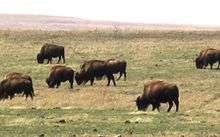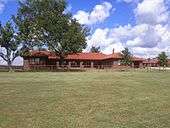Tallgrass Prairie Preserve
- This article is about the Tallgrass Prairie Preserve in Oklahoma. There is also a Tallgrass Prairie National Preserve in Kansas, a Midewin National Tallgrass Prairie in Illinois, and a Manitoba Tall Grass Prairie Preserve in Manitoba.
| Tallgrass Prairie Preserve | |
|---|---|
|
Tallgrass Prairie Preserve | |
 Map of Oklahoma | |
| Location | Osage County, Oklahoma |
| Nearest city | Pawhuska |
| Coordinates | 36°50′31″N 96°25′08″W / 36.842°N 96.419°WCoordinates: 36°50′31″N 96°25′08″W / 36.842°N 96.419°W |
| Area | 45,000 acres (18,000 ha) |
| Established | 1989 |
| Governing body | The Nature Conservancy |
The Tallgrass Prairie Preserve, located in Osage County, Oklahoma near Foraker, Oklahoma, is owned and managed by The Nature Conservancy. It is protected as the largest tract of remaining tallgrass prairie in the world. The preserve contains 39,000 acres (160 km2) owned by the Conservancy and another 6,000 acres (24 km2) leased in what was the original tallgrass region of the Great Plains that stretched from Texas to Manitoba.[1][2]
Description
The preserve is located at the southern end of the Flint Hills, a rocky, rolling prairie that stretches from northern Kansas into Oklahoma. Exposed limestone formations make cultivation difficult, and thus the Flint Hills have survived much as they were when they were an Indian hunting ground for tribes such as the Wichita, Osage, and Kaw. The region is called “The Osage” by Oklahomans, referring to the name of the county and the Indian tribe to which the land belonged. Pilots call The Osage the “Black Hole” when flying over it at night because it is so lightly populated.[3]

Prior to its purchase by the Nature Conservancy in 1989, the preserve was called the Barnard Ranch which had been part of the Chapman-Barnard ranch of 100,000 acres (400 km2).[4] The foreman of the Chapman-Barnard ranch, Ben Johnson, Sr. was a rodeo champion. His son, also a rodeo champion, was Ben Johnson, Jr. who appeared in more than 300 movies and won an Oscar for his role in “The Last Picture Show.”[3]
The preserve is bisected by well-timbered Salt Creek and its tributaries. The eastern portion of the preserve is in the Cross Timbers, a north-south running belt of tangled oak forests that were a major impediment to early travelers heading west.[3] About 10 percent of the preserve is forested and the remainder is tallgrass prairie with grasses of several species that can grow 10 feet (3 m) tall.[5]
The tallgrass prairie owes its existence to fire, whether caused by lightning or manmade. Without fire, the prairie quickly becomes brushland. The Indians were aware of this and burned the prairie regularly to nurture new growth of succulent grasses and to kill intrusive trees and shrubs. The Nature Conservancy has continued this practice with a process called “patch burning” in which about one-third of the prairie is burned each year.[6] This process has proven beneficial not only for bison and cattle, but also for the threatened greater prairie chickens which also inhabit the preserve in small numbers.
Bison are the most prominent attraction of the preserve. An Oklahoma oilman, Kenneth Adams, donated 300 bison to the preserve in 1993. By 2000, the herd had increased to 1,200.[6] The herd now numbers more than 2,500 and grazes 21,000 acres (85 km2) of mostly open range. Bison are rounded up each fall and the excess numbers sold. Cattle are grazed on 11,000 acres (45 km2). The preserve supports 755 plant species, many unique to the tallgrass prairie, and more than 300 bird species.[5][7] Forest trees include several species of oak, cottonwoods, ash, red cedar, elm, sycamore, and others.
The Tallgrass Prairie Preserve is on what used to be the Osage Indian Reservation. The Osage Indians[8] retained sub-surface mineral rights on all their former lands and the petroleum on their reservation made them the richest people per capita in the world in the 1930s. Today, bison graze among the more than 100 producing oil wells on the preserve.[3]
The preserve is home to numerous interesting invertebrates species. In addition to the many species of butterflies and moths that feed and host on the flowering plant biodiversity found there, the prairie mole cricket (Gryllotalpa major) is a rare insect species found on the preserve. Males locate on leks in large numbers in the spring months (April–May) to produce loud choruses from calling burrows to attract flying females. In the summer months the preserve serves as habitat for the endangered American burying beetle (Nicrophorus americanus), which plays an important role in nutrient cycling.
Visiting and recreation

Pawhuska, Oklahoma, is the nearest large town. The preserve may also be entered near Foraker, Oklahoma, and Hewins, Kansas. The Tallgrass Prairie Preserve is open every day from dawn to dusk. There is no admission charge. The headquarters of the Chapman-Barnard ranch has been converted into a visitor center with restrooms, a gift shop, and the restored bunkhouse in which the cowboys lived. The main building is listed in the National Register of Historic Places (NR 01000208).[6] The gift shop is open from 10 a.m. to 4 p.m from March to mid-November. Oklahoma State University has a research station at the visitor center.
Near Salt Creek are two hiking trails. One is a short nature trail; the other is a 2-mile (3 km) trail that climbs to overlooks over the creek and through the riparian forest. Frequently, bison are seen just across the fence that separates the hiking area from grazing areas. White tailed deer are abundant in the wooded areas.
The principal activity for the 10,000 visitors to the preserve yearly is driving the many dirt roads to observe the bison. It is a rare visitor who does not see hundreds of bison near – and often blocking – the roads. There are scenic turnouts along the roads and broad vistas of rolling prairie, emerald green in spring, tall and brown in fall, and dotted with wildflowers in the summer.[1]
References
- 1 2 "Tallgrass Prairie Preserve". nature.org. The Nature Conservancy. Retrieved March 11, 2012.
- ↑ Rinehart, Bill (April 22, 2005). "Across the Fence : Patch Burning Results". oklanature.com. Retrieved March 11, 2012.
- 1 2 3 4 Jones, Jr., Jenk. "Osage County History". oklanature.com. Retrieved March 11, 2012.
- ↑ Warehime, Les (2000). History of Ranching the Osage. Tulsa, OK: W.W. Publishing. p. 253.
- 1 2 Hamilton, R.G. (2007). "Restoring heterogeneity on the Tallgrass Prairie Preserve: applying the fire–grazing interaction model". Pages 163–169 in R.E. Masters and K.E.M. Galley (eds.). Proceedings of the 23rd Tall Timbers Fire Ecology Conference: Fire in Grassland and Shrubland Ecosystems. Tall Timbers Research Station, Tallahassee, Florida, USA.
- 1 2 3 Larry. O'Dell, " Tallgrass Prairie Preserve." Encyclopedia of History and Culture.
- ↑ "Tallgrass Prairie Preserve". TravelOK.com. Oklahoma Tourism & Recreation Department. Retrieved March 11, 2012.
- ↑ Osage Nation
External links
- http://www.nature.org/ourinitiatives/regions/northamerica/unitedstates/oklahoma/placesweprotect/tallgrass-prairie-preserve.xml
- Tallgrass Prairie Preserve
- Tallgrass Prairie Preserve page including photos and videos on TravelOK.com - Oklahoma's Official tourism website
- Restoration Row, New York Times article by Timothy Egan, May 28, 2008
- Voices of Oklahoma interview with Harvey Payne and Jenk Jones First person interview conducted on July 15, 2014 with Harvey Payne and Jenk Jones talking about the Tallgrass Prairie Preserve. Original audio and transcript archived with Voices of Oklahoma oral history project.
